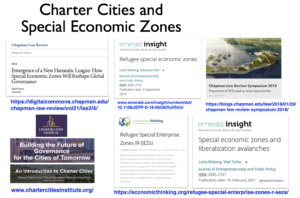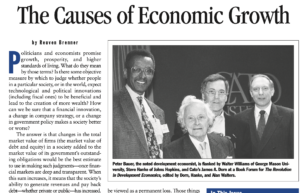Refugee Special Enterprise Zones (R-SEZs)… [Updated]
Many proposals call for the European Union to increase skilled immigration, as well as reforms for less skilled immigrants and asylum seekers. Populist and nationalist groups say new immigrants will “take” jobs locals could fill and pull wages down toward levels in poorer countries. Refugees are believed to be a burden on already strained national and E.U. budgets as well as creating cultural challenges.
E.U. immigration reformers can learn from dynamic cities today and from Europe’s past migration successes. European cities for centuries prospered from international trade, investment, and migration. Fast expanding cities attracted millions from the countryside as well as more distant places (more European history below).
Proposed Special Economic Zones for Refugees offer a better life for millions today trapped in refugee camps, including refugees trying to enter Europe. Earlier posts have discussed the worldwide migration to Arrival Cities over recent decades. The European Union and other international organizations could embrace policy reforms to assist host countries open enterprise zones adjacent to refugee camps. These new SEZs would attract international investment to create jobs for both local workers and refugees.
Lotta Moberg and Sebastian Reil, in Refugee special economic zones (Journal of Enterprise and Public Policy, July 11, 2018), make the case for how: “SEZs as tools for institutional entrepreneurs…may be applied to refugee camps.” They argue “SEZs can be combined with refugee camps to provide opportunities for investors, refugees and governments alike, and eventually lead to wider immigration policy reforms.”
The world’s largest SEZ success is the city of Shenzhen in China, now home to between over twelve million, most migrants and children of migrants from rural China. When granted SEZ status in 1980 just 60,000 lived in Shenzhen. “Economic refugees” from impoverished rural China migrated to work in new factories built by foreign companies. Over decades Shenzhen area factories, skill levels, tech services, pay, and profits have increased dramatically.
Migrants from rural China to Shenzhen weren’t formally “refugees” and didn’t need to cross borders, but most work and live informally due to lack of government residency permits. Migrant workers without these papers are referred to as the “floating population.” To Float or Not to Float? Internal Migration of Skilled Laborers in China (Int. Journal Environ. Res. Public Health, December 4, 2020) reports Shenzhen’s floating population at over 50%:
…the floating population constitute over 25% of total population in most counties in the Yangtze River Delta (YRD), the Pearl River Delta (PRD), the Jing–Jin–Ji region (JJJ), and inland provincial capitals, and a few even above 50% (e.g., Shenzhen and Dongguan).
Refugee special economic zones (R-SEZs)
So could new Hong Kong/Shenzhen style refugee special economic zones be created adjacent to current refugee camps? Section 5 in Refugee special economic zones explains:
5. How would R-SEZs work?
R-SEZs would introduce reforms of refugee policies in confined areas. Similar to traditional SEZs, R-SEZs would provide entrepreneurs with an attractive business climate that would not be pursued in the economy as a whole due to political resistance.While most SEZs focus on manufacturing, an R-SEZ could host all kinds of economic activities, depending on available resources, worker skills and possible markets. By connecting an R-SEZ to a refugee camp, the skills and experience or refugees can be harnessed to provide refugees themselves with better opportunities while developing an underdeveloped part of the host country.
Refugees can either work for zone investors or pursue their own entrepreneurial ventures. The zone model should greatly enhance the opportunities of refugees to do business. …
Are there really investors interested in funding a R-SEZ? Consider recent news, Athens asks for EU help in returning migrants to Turkey (i24News, January 14, 2021):
Greece appealed to the EU after Turkey refused to reclaim the asylum seekers, who are currently living in refugee camps located on a number of Greek islands near the Turkish coast.
At least 995 migrants are on Lesbos; 180 in Chios; 187 in Kos, and 128 in Samos, a statement from Athens said. …
But Turkey accuses the EU of not having fulfilled its obligations as 3.6 million mostly Syrian refugees are currently residing on its territory.
With millions of refugee in Turkey, and about 50,000 current in Greece, would there be funding for a R-SEZ on a Greek island? Tenacious Egyptian Billionaire Offers $100 Million To Help Refugees (Forbes, May 7, 2016) profiles one impatient investor:
Last September, Naguib Sawiris, one of the world’s most audacious and ultimately successful entrepreneurs, offered to buy an island for refugees in the Mediterranean and help them build a community.

Article links” • https://digitalcommons.chapman.edu/chapman-law-review/vol21/iss2/4/ • www.emerald.com/insight/content/doi/10.1108/JEPP-D-18-00030/full/html https://blogs.chapman.edu/law/2018/01/29/chapman-law-review-symposium-2018/ • https://economicthinking.org/refugee-special-enterprise-zones-r-sezs/ • https://www.emerald.com/insight/content/doi/10.1108/JEPP-01-2021-0008/full/html
Proponents of SEZs seek to seize opportunities
Many articles on SEZs and Charter Cities are featured in this Chapman Law Review Symposium 2018 looking at “Special Jurisdictions Within and Outside of the United States,”
“We’re in this kind of Cambrian age of zones,” said panelist Tom W. Bell, Fowler professor of law and author of a new book on special jurisdictions, Your Next Government? From the Nation State to Stateless Nations. …
Keynote speaker John Chisholm, a Silicon Valley entrepreneur and angel investor, addressed law students and legal professionals in a talk titled “Design the Optimal Legal System for Your SEZ.” …
The symposium’s final session considering the future of SEZs featured Mark Frazier, chairman of the Startup Societies Foundation, and Sam Mulopulos, an expert on international trade, banking, housing, technology and communications with extensive Capitol Hill experience. It was moderated by Bell.
Mark Frazier’s Chapman Law paper Emergence of a New Hanseatic League: How Special Economic Zones Will Reshape Global Governance includes discussion of new SEZs as an alternative for millions of refugees:
Such initiatives can resolve one of the great challenges to international and national legal systems: providing a solution for the more than sixty million economic migrants, refugees, and stateless persons fleeing from breakdowns of their nation states. A new generation of World Cities—immigration- friendly areas of economic reform comparable in size to Hong Kong and Singapore—can be privately developed as havens for those who demonstrate skills and build reputations in online free markets. This article maps opportunities for a New Hanseatic League of free zones and free cities to fill voids left by dysfunctions in present systems of local, regional, and national governance. …
…A growing need exists for entrepreneurial areas of policy reform and technological innovation to link up and lay the groundwork to bring transparent rule of law and new kinds of economic opportunity within reach of all on the planet.
To explore how this scenario can practically unfold, it is useful to go back eight centuries to the early days of the Hanseatic League, a self-organizing network of free zones and free cities that endured for centuries and enabled much of Northern Europe to flourish. An updated version of the Hanseatic League open to participants across the globe can advance systemic changes in governance at all levels. In coming years, it could prepare tools for self-governance in voluntary communities and lay groundwork for new transcultural, immigration-friendly World Cities to cope with rising flows of migrants and refugees. And as entrepreneurs bring breakthrough technologies to market, a New Hanseatic League could offer a transnational framework for creating startup societies on the oceans and in space. [Source: Emergence of a New Hanseatic League: How Special Economic Zones Will Reshape Global Governance]
A European History of Migration to Cities
People should have a say in their governance, but not a say in how other people’s lives should be governed. Richard Pipes in Property and Freedom outlines the ancient view of government considered just when it enforced the laws already existing in society. Grotius and other legal scholars emphasized that society was not the state, and the state’s legitimate reach did not extend to private life, liberty and property. These views of just government were debated and those defending divine rule and absolute authority for English kings lost the debate. The Dutch model of a commercial society self-governed with royalty of limited power came to England with William of Orange, replacing the French model James II had recently installed by force across the country. (Highly recommended: 1688: The First Modern Revolution.) [Note paragraph above from Encourage Economic Freedom or Democracy for the Middle East?, EconomicThinking, updated June 27, 2018.)
 More on Dutch commercial society in Reuven Brenner’s “The Causes of Economic Growth” (pdf online here) which looks at past economic “miracles” powered by toleration, freedom, and immigration:
More on Dutch commercial society in Reuven Brenner’s “The Causes of Economic Growth” (pdf online here) which looks at past economic “miracles” powered by toleration, freedom, and immigration:
The miracle of 17th-century Europe was neither Spain nor Portugal—both of which fit the “finding treasure” mold—but below- sea-level Amsterdam and Holland, whose riches were created despite natural obstacles. Later there was West Germany, rising miraculously from the ashes of World War II. There were some Asian miracles that deserve our attention, such as those of Hong Kong and Singapore. And there was the almost forgotten example of Scotland, which teaches a particular lesson.
What’s common to all those miracles? The Dutch were the first European republic, both tolerant toward all religions (when the rest of Europe was still severely discriminating against many) and with sound rights to property, which opened opportunities for relatively unhindered trade and financial innovation.
But it would be misleading to say that “the Dutch” did it. The openness of the new republic attracted to Amsterdam well-connected and educated immigrant merchants and moneymen (bankers from northern Italy); Jews and Huguenots, discriminated against elsewhere in Europe, were prominent among them. They helped turn Amsterdam into the financial and trading center of the 17th-century world. It had the world’s first stock market, where French, Venetians, Florentines, and Genoese, as well as Germans, Poles, Hungarians, Spaniards, Russians, Turks, Armenians, and Hindus traded not only in stocks but also in sophisticated derivatives.
Much capital active in Amsterdam was foreign owned, or owned by Amsterdammers of foreign birth. There was “globalization” during the 17th century, even if nobody bothered to use the term. …
Brenner cites other cities where zones of economic freedom and rule of law attracted migrants:
The histories of Hamburg, Hong Kong, Singapore, Taiwan, and West Germany have much in common with Amsterdam’s, but shared religion is not a factor. In each of those places, the state provided an umbrella of law and order, exacted relatively low taxes, and gave people a stake in what the business society was doing—thereby attracting immigrants and entrepreneurs from around the world.
And another migration success story from Europe, the German economic miracle after World War II, powered more by economic reforms and migration than by the Marshall Plan:
The post–World War II West German miracle fits this pattern too, though in popular memory its success is associated with the Marshall Plan. The impact of that aid has been greatly exaggerated. Historians and economists (subsidized by governments) are very good at creating and perpetuating myths. At times the myths are about nationalism, falsely suggesting that economic miracles have been due to the genius of people living within arbitrary national borders. At times they are about the extremely beneficial roles of foreign aid. Both types of myth conveniently justify increasing the power placed in the hands of government. …
So what fueled the West German miracle? From 1945 to 1961, West Germany accepted 12 million immigrants, for the most part well trained. About 9 million were Germans from Poland and Czechoslovakia. Others fled East Germany’s communist paradise. …
And when the European inflow stopped, new waves of skilled young employees arrived from Mediterranean lands. In other words, the West German miracle was due, not to foreign aid, but to the same features that brought about earlier and later miracles elsewhere: migration of skilled people and significantly lower tax rates.
Quotes above from Reuven Brenner’s “The Causes of Economic Growth” (Cato Policy Report, May/June 1998) (pdf online here).
Institutional reforms that R-SEZs can bring would allow refugees more access to international investment and to the global economy.
